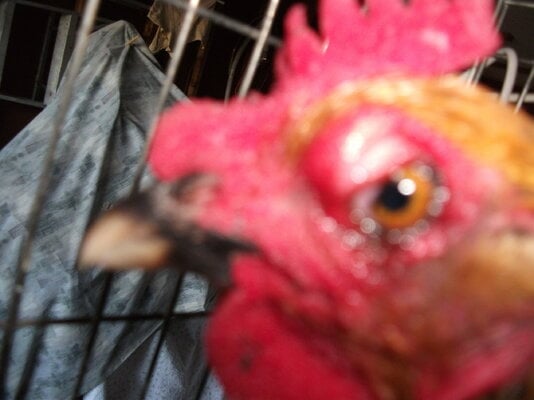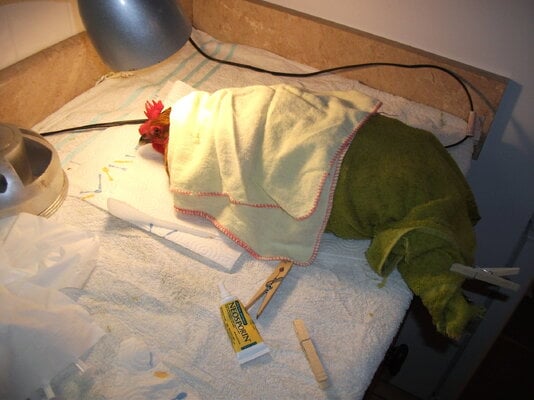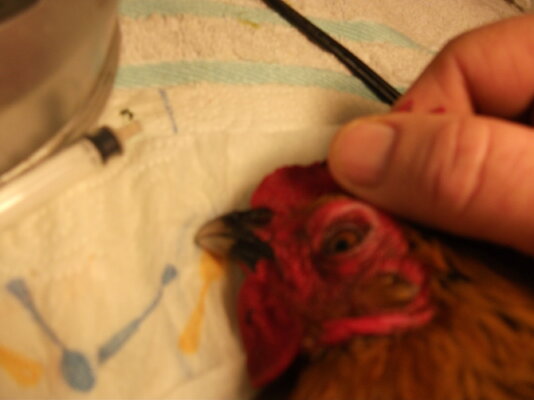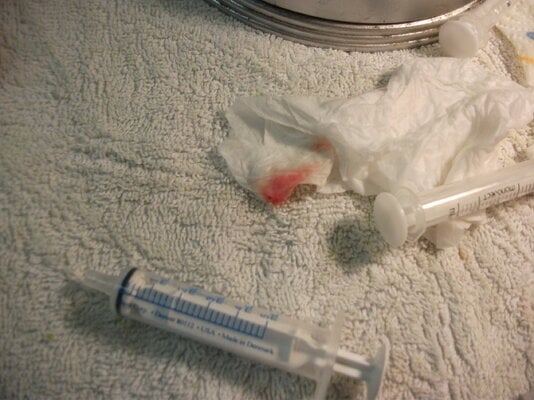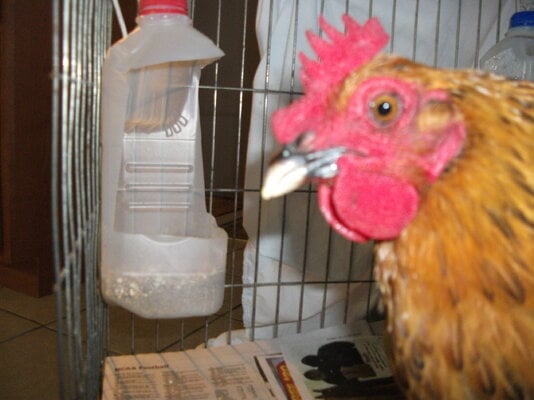chickieBok
Chirping
- Mar 1, 2023
- 9
- 51
- 54
Hi BYC community, I’m writing because my girls have me stumped. I have a small mixed flock of 4 that I adopted as chicks from a local farm in Feb: a Barnevelder, 2 Americauna / EE, and one that was supposed to be a Cuckoo Maran, now suspected to be a Barred Rock.
It started last Tuesday (5 days ago) when I noticed swelling in my Barnevelder’s (Rubi) eyelid and surrounding eye area with some redness (affected vs unaffected eye in first 2 photos). After some intense research, I wearily concluded that it must have been a sting of some sort since to me, it looked like there was an area on the eyelid that appeared more raised than the rest (a small initial bump with no apparent physical damage), but she seemed to have absolutely no other symptoms other than the swelling, with maybe slight congestion that seemed understandable with sinus swelling (no rattles or coughs, just a deeper cluck that seemed gone the next day). I checked the other girls and didn’t see any swelling like hers; they were frolicking about happy as could be as I snapped photos of them. I decided to closely monitor Rubi as she was still acting completely normal, eating and drinking.
Three days went by (next few photos) and the swelling and redness seemed to subside ever so slightly. No congestion, coughs, or sneezes.
I chose not to interfere as I really try to take that “let nature run its course” approach unless absolutely necessary, since I am a chronic over-parenter; especially since it didn’t seem to affect her behavior or appetite. She’s also the most aloof of my girls, so I take extra care not to make her additionally weary of me unless I have to.
I relaxed a bit since it certainly wasn’t getting worse, but I still didn’t feel 100% confident about the sting diagnosis since there aren’t any hives on our property that I could find.
Fast forward to Saturday AM (when I started writing this) and that is when I first saw the small bump and minor swelling around the eye of the second bird, an “EE” Marmalade.
I immediately looked back on my photos to compare again the last few days, trying to confirm the swelling had been subsiding on Rubi and it wasn’t just my hopeful eye- I then discovered Marmalade had actually presented a very small bump in her lower lid on the second day of monitoring (Wednesday, see photos) - I had totally missed it because there was NO swelling around the eye at this initial stage, which is what I had been looking for. Now I knew it couldn’t be a second, already unlikely sting.
My fiancé suggested mosquitos which made perfect sense to me, until I couldn’t find anything solid about their bites being this much of a problem for chickens.
There are no eye bubbles, no foam- just a very small amount of clear discharge occasionally, not constantly. I’ve seen both affected girls scratch their faces as if it is possibly itchy. It’s affecting the right eye (their right) on both girls.
As of today (Sunday AM), Marmalade is noticeably more swollen where Rubi looks much less so (last photos). They aren’t exhibiting any other typical behaviors of either MG or Coryza which is why I am here.
I am desperately hoping someone recognizes something in their photos that I am not able to, as no photos I’ve found of either disease or any eye swelling on this site or the wide web has matched what I’m seeing on my girls.
I was hesitant to start them on the Tylan 50 since I have been unable to confirm any other persistent symptoms other than the eyelid and face swelling, and the initial small bumps don’t seem to fall under anything but a bite or pox.
I also filled out the questionnaire below for those that prefer to read that way; I tried to make sure all necessary info was present either there or in the paragraphs above.
I apologize deeply for the long winded post, but I want to include anything of possible relevance and please let me know if more information is needed. THANK YOU IMMENSELY FOR READING.
1) What type of bird , age and weight (does the chicken seem or feel lighter or thinner than the others.)
Born end of Feb 2023, 1 Barnevelder and 1 Americauna seem affected out of 4 girls. No noticeable weight changes, and none have begun to lay as of today.
2) What is the behavior, exactly.
See above
3) How long has the bird been exhibiting symptoms?
5 days now.
4) Are other birds exhibiting the same symptoms?
Only the 2 birds out of 4 have exhibited the initial eyelid bumps, then the eyelid/ eye area swelling.
5) Is there any bleeding, injury, broken bones or other sign of trauma.
No signs of physical trauma- no blood, scratches, cuts, or scabs.
6) What happened, if anything that you know of, that may have caused the situation.
I am utterly stumped. At first I thought bee, but I think that is now much less likely with two birds presenting. Fiancé suggested mosquitos?
7) What has the bird been eating and drinking, if at all.
I feed Nutrena Starter Grower crumble, with daily dandelion greens, occasional millet on the chillier days, and occasional kitchen scraps. They have access to chick grit in addition to the rocky soil outside, as well as 1 fresh litre of plain water with nipple drinker that they have always used. Sometimes they seem to be consuming slightly less water than normal, but I am knowingly over critical. Our weather has been absolutely bonkers here in zone 6A over the last 2 weeks. Super hot and muggy last week, now it’s 30 degrees cooler.
8) How does the poop look? Normal? Bloody? Runny? etc.
Poop looks normal, and what seems to be a normal amount of cecal.
9) What has been the treatment you have administered so far?
None, as I did not want to interfere with a suspected bee sting initially since there was no stinger to remove. And then once I noticed the second bird, I haven’t wanted to attempt to treat anything that I was unsure of. I have Tylan 50 on hand.
10 ) What is your intent as far as treatment? For example, do you want to treat completely yourself, or do you need help in stabilizing the bird til you can get to a vet?
Ideally, I prefer to avoid the fees of the vet unless it is an absolute life-threatening emergency. While they do double as my pets, we try to be as self-sufficient and self-sustaining as possible where possible. I trust community input over my lack of hands-on experience; research only gets you so far until something wonky like this happens!
11) If you have a picture of the wound or condition, please post it. It may help.
See below!
12) Describe the housing/bedding in use
They live in a roughly 6x4x5 raised coop built inside a ventilation-modified shed with daily access to a 6x9x6 run and their chicken garden (pallet w/ safe plants- only serving grass currently). I was tedious about personally making sure there are zero sharp points or edges, and bo leftover sharp material after construction (additionally, I have yet to see any bullying between the fab 4) Planning to let them out for supervised free ranging when my schedule settles. We use the large pine bedding flakes from TSC.
TIMELINE OF PHOTOS
Tuesday, Rubi

Unaffected eye, same moment

Wednesday, Marmalade (the small bump I did not initially notice until later reviewing these photos)


Marm (affected) & Roweena (unaffected)

Wednesday, Rubi



(no photos of marmalade, as this was before I reviews the photos)
Thursday, Rubi


Saturday, PM: Marm and Rubi


Sunday, AM (visibly increased swelling on Marm)



It started last Tuesday (5 days ago) when I noticed swelling in my Barnevelder’s (Rubi) eyelid and surrounding eye area with some redness (affected vs unaffected eye in first 2 photos). After some intense research, I wearily concluded that it must have been a sting of some sort since to me, it looked like there was an area on the eyelid that appeared more raised than the rest (a small initial bump with no apparent physical damage), but she seemed to have absolutely no other symptoms other than the swelling, with maybe slight congestion that seemed understandable with sinus swelling (no rattles or coughs, just a deeper cluck that seemed gone the next day). I checked the other girls and didn’t see any swelling like hers; they were frolicking about happy as could be as I snapped photos of them. I decided to closely monitor Rubi as she was still acting completely normal, eating and drinking.
Three days went by (next few photos) and the swelling and redness seemed to subside ever so slightly. No congestion, coughs, or sneezes.
I chose not to interfere as I really try to take that “let nature run its course” approach unless absolutely necessary, since I am a chronic over-parenter; especially since it didn’t seem to affect her behavior or appetite. She’s also the most aloof of my girls, so I take extra care not to make her additionally weary of me unless I have to.
I relaxed a bit since it certainly wasn’t getting worse, but I still didn’t feel 100% confident about the sting diagnosis since there aren’t any hives on our property that I could find.
Fast forward to Saturday AM (when I started writing this) and that is when I first saw the small bump and minor swelling around the eye of the second bird, an “EE” Marmalade.
I immediately looked back on my photos to compare again the last few days, trying to confirm the swelling had been subsiding on Rubi and it wasn’t just my hopeful eye- I then discovered Marmalade had actually presented a very small bump in her lower lid on the second day of monitoring (Wednesday, see photos) - I had totally missed it because there was NO swelling around the eye at this initial stage, which is what I had been looking for. Now I knew it couldn’t be a second, already unlikely sting.
My fiancé suggested mosquitos which made perfect sense to me, until I couldn’t find anything solid about their bites being this much of a problem for chickens.
There are no eye bubbles, no foam- just a very small amount of clear discharge occasionally, not constantly. I’ve seen both affected girls scratch their faces as if it is possibly itchy. It’s affecting the right eye (their right) on both girls.
As of today (Sunday AM), Marmalade is noticeably more swollen where Rubi looks much less so (last photos). They aren’t exhibiting any other typical behaviors of either MG or Coryza which is why I am here.
I am desperately hoping someone recognizes something in their photos that I am not able to, as no photos I’ve found of either disease or any eye swelling on this site or the wide web has matched what I’m seeing on my girls.
I was hesitant to start them on the Tylan 50 since I have been unable to confirm any other persistent symptoms other than the eyelid and face swelling, and the initial small bumps don’t seem to fall under anything but a bite or pox.
I also filled out the questionnaire below for those that prefer to read that way; I tried to make sure all necessary info was present either there or in the paragraphs above.
I apologize deeply for the long winded post, but I want to include anything of possible relevance and please let me know if more information is needed. THANK YOU IMMENSELY FOR READING.
1) What type of bird , age and weight (does the chicken seem or feel lighter or thinner than the others.)
Born end of Feb 2023, 1 Barnevelder and 1 Americauna seem affected out of 4 girls. No noticeable weight changes, and none have begun to lay as of today.
2) What is the behavior, exactly.
See above

3) How long has the bird been exhibiting symptoms?
5 days now.
4) Are other birds exhibiting the same symptoms?
Only the 2 birds out of 4 have exhibited the initial eyelid bumps, then the eyelid/ eye area swelling.
5) Is there any bleeding, injury, broken bones or other sign of trauma.
No signs of physical trauma- no blood, scratches, cuts, or scabs.
6) What happened, if anything that you know of, that may have caused the situation.
I am utterly stumped. At first I thought bee, but I think that is now much less likely with two birds presenting. Fiancé suggested mosquitos?
7) What has the bird been eating and drinking, if at all.
I feed Nutrena Starter Grower crumble, with daily dandelion greens, occasional millet on the chillier days, and occasional kitchen scraps. They have access to chick grit in addition to the rocky soil outside, as well as 1 fresh litre of plain water with nipple drinker that they have always used. Sometimes they seem to be consuming slightly less water than normal, but I am knowingly over critical. Our weather has been absolutely bonkers here in zone 6A over the last 2 weeks. Super hot and muggy last week, now it’s 30 degrees cooler.
8) How does the poop look? Normal? Bloody? Runny? etc.
Poop looks normal, and what seems to be a normal amount of cecal.
9) What has been the treatment you have administered so far?
None, as I did not want to interfere with a suspected bee sting initially since there was no stinger to remove. And then once I noticed the second bird, I haven’t wanted to attempt to treat anything that I was unsure of. I have Tylan 50 on hand.
10 ) What is your intent as far as treatment? For example, do you want to treat completely yourself, or do you need help in stabilizing the bird til you can get to a vet?
Ideally, I prefer to avoid the fees of the vet unless it is an absolute life-threatening emergency. While they do double as my pets, we try to be as self-sufficient and self-sustaining as possible where possible. I trust community input over my lack of hands-on experience; research only gets you so far until something wonky like this happens!
11) If you have a picture of the wound or condition, please post it. It may help.
See below!
12) Describe the housing/bedding in use
They live in a roughly 6x4x5 raised coop built inside a ventilation-modified shed with daily access to a 6x9x6 run and their chicken garden (pallet w/ safe plants- only serving grass currently). I was tedious about personally making sure there are zero sharp points or edges, and bo leftover sharp material after construction (additionally, I have yet to see any bullying between the fab 4) Planning to let them out for supervised free ranging when my schedule settles. We use the large pine bedding flakes from TSC.
TIMELINE OF PHOTOS
Tuesday, Rubi
Unaffected eye, same moment
Wednesday, Marmalade (the small bump I did not initially notice until later reviewing these photos)
Marm (affected) & Roweena (unaffected)
Wednesday, Rubi
(no photos of marmalade, as this was before I reviews the photos)
Thursday, Rubi
Saturday, PM: Marm and Rubi
Sunday, AM (visibly increased swelling on Marm)
Last edited:





